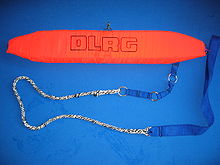Belt rescuer
The belt rescuer is an aid in water rescue . It consists of a chest-shoulder strap, a buoyant connecting line with eyelets and a float made of flexible materials (mostly foam).
application
On the way to the casualty, the lifeguard pulls the lifeguard behind him. When the lifeguard arrives at the casualty, he can hand him the belt rescuer to avoid clasping. The casualty can hold on to the belt rescuer and be pulled ashore by the lifeguard.
If the casualty is unconscious or does not have enough strength to hold on to the belt rescuer, the lifeguard can tie the belt rescuer around the chest of the casualty and drag him safely to shore.
Self-rescue
The lifeguard himself can get into a situation, for example when staying in the water for a long time, where he can hold on to the harness rescuer. The float offers additional safety even when deployed in the surf, as the lifeguard uses it as a buffer between himself and z. B. can hold rocks and groynes.
Rescue Sports
The belt rescuer is an important competitive device in rescue sports. It is used in the following disciplines:
- Rescuing a doll with fins and belt rescuer (50 m swimming with flippers , taking over the doll and 50 m dragging the doll with the belt rescuer)
- Super lifesaver (75 m freestyle, doll pickup, 25 m doll dragging, putting on fins and belt rescuer, 50 m fins swimming with belt rescuer, doll takeover, 50 m dragging of the doll with fins and belt rescuer)
- Belt rescue team
- Rescue Tube Rescue Race (open water discipline: A swimmer takes fins and the Gurtretter sprints in the surf and creates both He then floats to the buoy and puts the rescue harness to the waiting there second float The fin swimmers dragging the victim back to.. Beach in. waist-deep water, two helpers take the victim and carry it across the finish line)
advantages
- high intrinsic safety due to the float
- People in need of help can easily hold on to the safety belt
- ready for use quickly
- many uses
- easy maintenance
disadvantage
- putting on the belt rescuer on the casualty must be practiced
- difficult maintenance in the old version (orange). This problem has been resolved with the new version (yellow)
- not faint-proof

